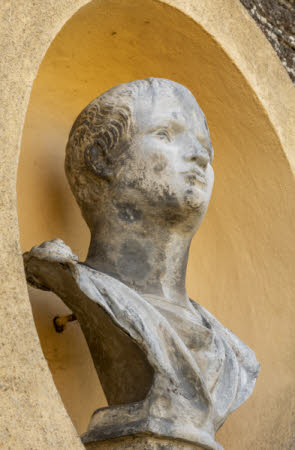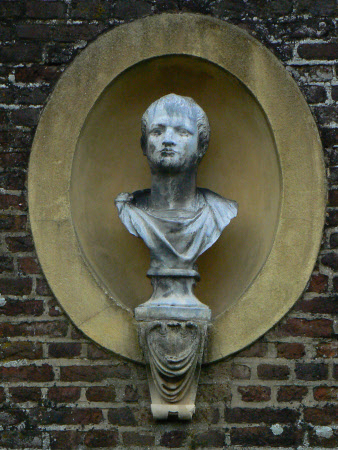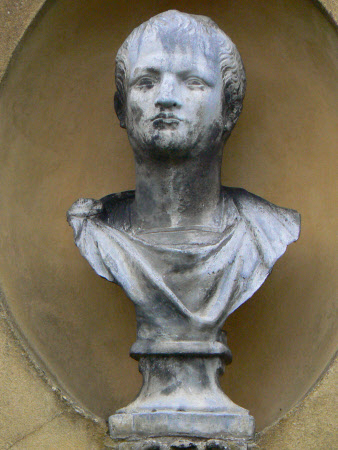Portrait bust of a Roman Emperor
workshop of John Besnier (fl.1681)
Category
Art / Sculpture
Date
c. 1670 - 1672
Materials
Lead, Sandstone
Measurements
770 mm (H)420 mm (W)
Order this imageCollection
Ham House, Surrey
NT 1140333
Summary
A lead portrait bust of a Roman emperor, wearing armour and a cloak. One of thirty-eight lead busts made for the garden walls of Ham House in 1671-72, perhaps in the workshop of John Besnier, thirty-six of which survive in niches on the walls and on the north façade of the house.
Full description
A lead portrait bust of a Roman emperor, dressed in armour, with the top of his corselet visible, and over this a cloak, fastened at the shoulder with a circular brooch. Mounted on a plinth, and placed on a sandstone console carved with a shield form and below a swag of drapery. The thirty-six lead busts that are displayed in oval niches in the garden walls and on the north façade of Ham House were probably installed in 1671-72, when the bricklayer John Burnell was paid between May 1671 and January 1672 ‘Ffor finishing ye Nic[h]es in ye forecourt..’ and then, in July and August 1672, the mason John Lampen received payment ‘Ffor mending ye flower potts + heads in ye forecourt…’ The 1679 inventory of Ham House recorded in the ‘Cloisters and fore-Court’ of Ham House ‘Six Marble heads/Thirty Eight heads of lead/two stone statuas upon stone pedestals.’ A drawing of the north front made by the antiquary John Aubrey in 1673-74 showed no busts in ovals (Rowell, Ham House. 400 Years of History, p. 105, fig. 95), confirming that the arrangement today, with eleven busts ranging along each garden wall, fourteen on the north façade and a single fethe Murraysmale bust on the east side of the house, must date from later. The busts today on the north façade can in fact be seen in a watercolour by Thomas Rowlandson dated 1803, suggesting that the reordering of the lead busts was undertaken as part of works by the 6th Earl of Dysart to open up this side of Ham House to the river, which were completed in 1803 (Rowell, Ham House, p. 361, fig. 371). The busts in their oval niches, then accompanied by hedges of phylleria, were from an early date regarded as a most important feature of the house, John Aubrey in around 1678 commenting on ‘ye walls lined withy philerea and Ovalls’, whilst the historian and collector Ralph Thoresby (1658-1725), who visited Ham House on 11 July 1712, described it as ‘…a very noble palace, though, to be fair, the spacious court before the more ancient front of the hall pleased me best, having a vast number of the bustos and the Roman Emperors, &c. in marble, each in a distinct niche in the wall, which were so surrounded by philerays, that no part of the walls appeared, there being nothing but delicate green, with white niches for the heads of the monarchs; amongst which also, that of King Charles the First.’ (Rev. Joseph Hunter, ed., The Diary of Ralph Thoresby F.R.S., 2 vols., London 1830, II, pp. 134-35; also cited by Avery, ‘Seventeenth-century Sculpture at Ham House’, p. 173). The reference to marble suggest that the busts, made of lead, had been painted white to simulate marble, at least from a distance. The series of lead busts at Ham essentially break down into: a large group of male busts, mostly after antique prototypes, including many Roman emperors; a smaller series of female busts, again mostly apparently after antique models but at least one derived from more a modern source; busts of King Charles I and his son Charles II. There are two complete series of the Twelve Caesars, with a sequence of eleven male busts along each garden wall and two isolated busts on the north façade of the house (NT 1140349 and 1140354). Each Caesar is repeated so there are two versions of each bust, thus the cousin of the present emperor is NT 1140370. The concept of the Twelve Caesars in art was based on the Roman historian Suetonius’s biographical collection of that name, as well as descriptions of these historical figures by other Roman writers such as Tacitus. The ‘twelve Caesars’ were the rulers of Rome, from the dictator Julius Caesar (100-44 B.C.) through to Domitian (51-96 A.D.) and included such famous or infamous figures as Augustus, Caligula and Nero. The sequence was especially influential and popular from the sixteenth to the eighteenth centuries. The most celebrated cycle of portraits of Roman emperors in Britain before the Civil War was a series of paintings by Titian of eleven emperors, the series completed by a twelfth Emperor by Bernardino Campi, which Charles I had bought from the Gonzaga collections in Mantua. Sold during the Commonwealth, they were subsequently destroyed in a fire in the Alcazar in 1734. Although it was in the country for no more than a couple of decades, Titian’s lost series could well have acted as a stimulus to the production of other series of images of the Twelve Caesars in Britain, including the two series at Ham, although the lead busts do not seem to be based on Titian’s images. Although some of the emperors at Ham can be identified, most of the portraits are too generalised for them to be matched to a specific emperor. The female busts include some portraits based on Roman prototypes, but a number are also derived from more modern sources. Much of the sculpture at Ham House was made over a period of around forty years, from the I1630s, when Catherine Bruce and her husband William Murray began a series of interventions in the house, to the early 1670s and the Murray's daughter Elizabeth and her husband John, 1st Duke of Lauderdale. In between came the Civil War and its aftermath, a calamitous period for this strongly royalist family, which was able with the Restoration to recover its former positions and wealth. The quite plausible suggestion has been made (by Charles Avery, in ‘Seventeenth-century Sculpture at Ham House’), that most of the sculpture was made for the house in the workshops of a single dynasty of sculptors, the Besnier family. French in origin, members of the family were appointed as ‘Sculptor in Ordinary’ to, successively, Kings Charles I and II, beginning with Isaac Besnier, who was employed to look after the ‘Moulds, Statues and Modells’ in the royal collections. Isaac probably arrived in London around 1625, perhaps in the retinue of Charles I’s bride Henrietta Maria, and may have left by 1643, when his responsibilities for the sculptures in the royal collections were transferred to his younger brother Peter Besnier (fl. 1643, died 1687/88), to whom is attributed the magnificent bronze bust of Catherine Bruce at Ham House (NT 1139887) as well as the plaster figures of Mars and Minerva in the Great Hall (NT 1139652.1 & 2). After the Restoration Peter Besnier petitioned the new king for restoration of his post and continued to work as a sculptor. His son Thomas (c. 1663-1693) was much praised by George Vertue, whilst another family member, John Besnier, was recorded in 1681 making lead statues for the Duke of Ormonde. Given the close relations between successive monarchs and the owners of Ham, it is a plausible hypothesis that the Besnier, in the service of the Crown, might have made much of the sculpture at Ham House.There is certainly some continuity of style between sculptures made for Ham before the Civil War and the series of lead busts, notably the varied plinths on which the busts are placed, some of which have the sort of late Mannerist auricular decoration to be seen on the socle of the bust of Catherine Bruce or the shields held by Mars and Minerva. It is not known how closely members of the Besnier family worked as a single workshop, but John, documented as making lead statuary, might have played a major role in making the lead busts at Ham. Jeremy Warren January 2022
Provenance
Probably made and installed in 1671-72, to the commission of John Maitland and Elizabeth Murray, 1st Duke and Duchess of Lauderdale. Thence by descent, until acquired in 1948 by HM Government when Sir Lyonel, 4th Bt (1854 – 1952) and Sir Cecil Tollemache, 5th Bt (1886 – 1969) presented Ham House to the National Trust. Entrusted to the care of the Victoria & Albert Museum until 1990, when returned to the care of the National Trust, to which ownership was transferred in 2002.
Makers and roles
workshop of John Besnier (fl.1681), sculptor
References
Avery 2013: Charles Avery, ‘Seventeenth-century Sculpture at Ham House’ in Christopher Rowell, ed., Ham House. 400 Years of History, New Haven/London 2013, pp. 158-77., pp. 172-76



